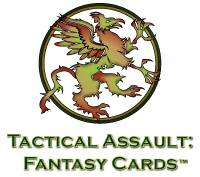Overview
The Tactical Assault: Fantasy Cards™ are a new and innovative way to approach your fantasy themed miniature gaming. The Fantasy Cards are designed to bring all the detailed elements of fantasy land warfare – including the fog of war – to the tabletop in a narrative card-driven format that is easy to play yet full of challenges. To be successful, you must be creative in your strategies, flexible in your tactics and attentive to the ever changing battlefield.
The Fantasy Cards can be utilized for just about any fantasy or pre-gunpowder historical setting, for any scale of miniatures, any sized battlefield and for any size of battle – ranging from the smallest skirmish action all the way up to massive army sized endeavors.
Designer’s Notes… Surrounded Enemies
Friday, March 4th, 2011One question that comes up from time to time is why isn’t there a Combat Results shift up when a foe is in close combat with multiple enemy units? The answer really is that the bonus for such a situation is already built into the system.
When a unit is surrounded by enemy units, the potential for a disaster for that unit is very high. If one of the surrounding enemy units has a Melee Surge Action, the result could force the surrounded unit to Fall Back leaving it vulnerable to Shots of Opportunity and Parting Blows from the other units surrounding it. If an attack does not force the surrounded unit to retreat, the attack could still leave the unit Shaken or Out of Action – thus giving any future attacks from the enemy units surrounding it an additional step up on the Combat Results chart. (more…)
How Do I… Use Urban Terrain
Tuesday, March 1st, 2011When laying out terrain on the tabletop battlefield, most forms of terrain are pretty easy and obvious to fit within the context of the Combat Cards. Woods are typically a Template of Covering Terrain, swamps are Templates of Hindering Terrain, hedges are Linear Obstructing Terrain and so on. The one form of terrain that often gives players fits is the dreaded ‘built up’ or ‘urban’ areas (e.g. cities, towns, villages and buildings).
Should urban areas be Templates of Impassable terrain? Or should each wall of a building be Linear Covering Terrain? Should roads be Clear Open Terrain, or should the walls and hedges that often run along them force them to be Obstructing Terrain? As players will play a host of different scales, genres and battlefield sizes there really isn’t a single authoritative answer to the question. What follows are some ideas which have proven effective in different types of games. Hopefully one them, or some combination of them, will help you lay out a better battlefield for your games. (more…)
(more…)
How Do I… Use Hex Maps
Monday, February 28th, 2011To play either the Combat Cards or the Fantasy Cards on a hex based map is very simple. In the either game, you take the shortest side and use that distance as your Very Long distance for the game. Half of that distance is the Long range, and so on. Well, instead of measuring that distance in inches or centimeters, you will simply measure it in terms of hexes.
Now some things do need a little tweaking to work, but they are very minor. When doing the math to determine distances, keep all the fractions as you half each distance. Then, when everything has been calculated, round any fractions to the nearest whole hex (up or down as appropriate).
For example, if you are going to play a Standard Game on a hex map 22 hexes wide, your Very Long range will be 22 hexes. Your Long range will be 11 hexes, your Medium range 6 hexes (5.5 rounded to 6), your Short range 3 hexes (2.75 rounded to 3) and your Very Short will be 1 hex (1.375 rounded to 1).
The other small tweaks are that all of the other rules (Lines of Sight, Cover, etc.) will now just apply to the hex rather than the model (though still center-to-center). Also, depending on the size of your hexes and the size of your models, you may have to set some “stacking” limits for the number of units allowed in a given hex. Otherwise you should be all set to enjoy a game on the multisided wonders that are hexes…





